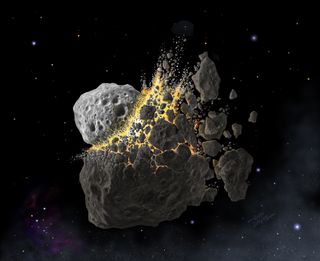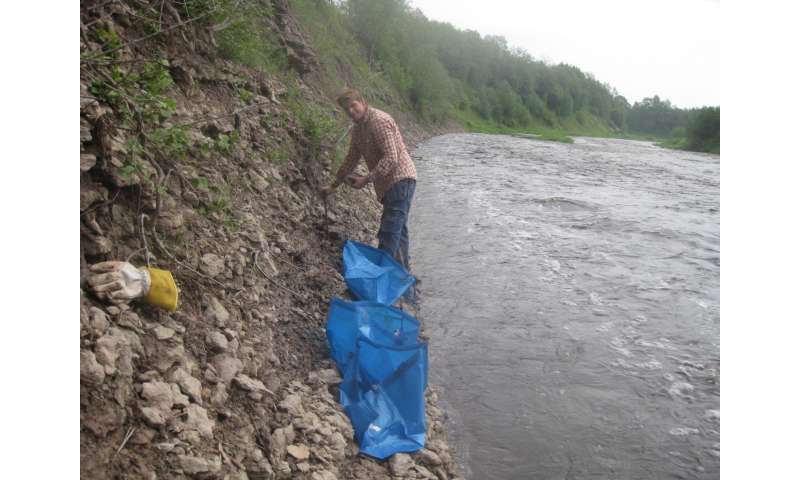Great Minds at Work Investigating, Interpreting, Counselling
"We've shown that what happens in the solar system can have a big influence on Earth. Extraterrestrial events aren't always destructive. Many people think about meteorites as just dinosaur killers, but we found the opposite. A big collision in the asteroid belt had constructive consequences that led to cooling and biodiversification."
"We're talking about gentle changes that happened over two million years. If we could travel back in time, it wouldn't appear as a catastrophe to us; it would be more like a gentle nudge that led to global change and triggered diversification."
Philipp Heck, curator of meteorites, Field Museum of Natural History, Chicago
"Our study is the first time it has been shown that asteroid dust actually helps cool Earth to a dramatic extent."
"Geologists often think of nothing outside Earth. You have to understand what happens in space to get the full picture of what's happened on Earth."
"We knew almost nothing about the meteorite flux to Earth in geological deep time before this study." "The conventional view is that the solar system has been very stable over the past 500 million years. So it is quite surprising that the meteorite flux at 467 million years ago was so different from the present."
Birger Schmitz, nuclear physicist, Lund University, Sweden
 |
An artist's depiction of an asteroid collision in outer space.
(Image: © Don Davis, Southwest Research Institute)
|
A distant, ancient asteroid collision generated sufficient dust to cause an ice age aeons ago on Earth, according to a study published last week in Science Advances. A research team that reached that conclusion and produced the study has given new insight into efforts that might address climate change.
Our planet Earth is exposed to extraterrestrial matter on a fairly frequent basis; no less than 40,000 tons of space dust settles here annually. A 150-kilometre-wide asteroid collided with a fast-moving object between Mars and Jupiter 466 years ago, the crash serving to increase the dust falling on Earth for the following two million years by a factor of 10,000.
Drs. Schmitz, Heck and their research team discovered that this voluminous fall of dust managed to trigger cooling in the atmosphere of Earth, leading to an ice age. Extraterrestrial dust in significant amounts has the potential of cooling the planet by blocking the amount of solar radiation reaching the surface of the planet. Since dust from this asteroid collision gradually accumulated, the cooling also resulted gradually, enabling plant and animal species to adapt, as sea levels dropped and temperatures descended by up to 50 degrees Fahrenheit.
Evidence was derived from a study of fossil meteorites, extraterrestrial materials embedded in Earth's rocks in antiquity, so rare Dr. Heck names them "Mona Lisas", the first one of which was discovered in a limestone quarry in Sweden in 1952, set aside by a paleontologist for future study, and identified 27 years later. A mineralogist realized in 1979 the origins of the rock, prompting a systematic search for additional such extraterrestrial material, resulting in the discovery of 130 meteorites over the following two decades.
 |
| Co-author Fredrik Terfelt of Lund University collecting rocks containing 467-million-year-old specimens |
On examination, Dr. Schmitz and his team determined fully 129 specimens were originally part of the same asteroid breakup. Their level of cosmic ray exposure was measured to confirm outer-space origins and determine their arrival on Earth when the meteorites were analyzed for chemical composition. Researchers were able to determine that extraterrestrial dust began its reach to Earth about 50,000 years after the asteroid collision, by tracing the increase of certain isotopes in the meteorites. Roughly ten thousand years later, during the Ordovician Period, a worldwide ice age was initiated.
The team hypothesized the collision might have increased dust levels by a hundredfold before they launched their research. However, the chemical analysis revealed that dust levels had increased by a far greater amount, by a factor of ten thousand, an increase quite sufficient to alter Earth's climate markedly. Out of that discovery came the attention to a mechanism that could conceivably be used in counteracting global warming.
In their recently-published paper, the research team propose an asteroid be captured and brought to one of the Lagrange points between the sun and Earth. An unstable zone where the gravitational pull of each of those celestial bodies is equal, allowing the production of dust to block sunlight. The use of extraterrestrial dust for global cooling has in fact been previously proposed by other scientists. Dr. Heck, however, has his doubts, considering their findings to represent a mere basis for investigation.
 |
| An undated photo of the slowly diminishing asteroid 6478 Gault, with a tail more than 800,000km long and some 5,000km wide. The dust from such objects may have been a factor in past global cooling on Earth. Read more at https://www.todayonline.com/world/how-cool-planet-extraterrestrial-dust NASA via New York Times |
"Putting a rock into an unstable point that could make it fall into Earth has me worried. A small asteroid wouldn't cause a global extinction, but it could cause a local catastrophe or wipe out a city in the worst case."
Labels: Astrogeology, Astrophysics, Earth, Global Warming, Ice Age, Meteor Collision, Science
0 Comments:
Post a Comment
<< Home